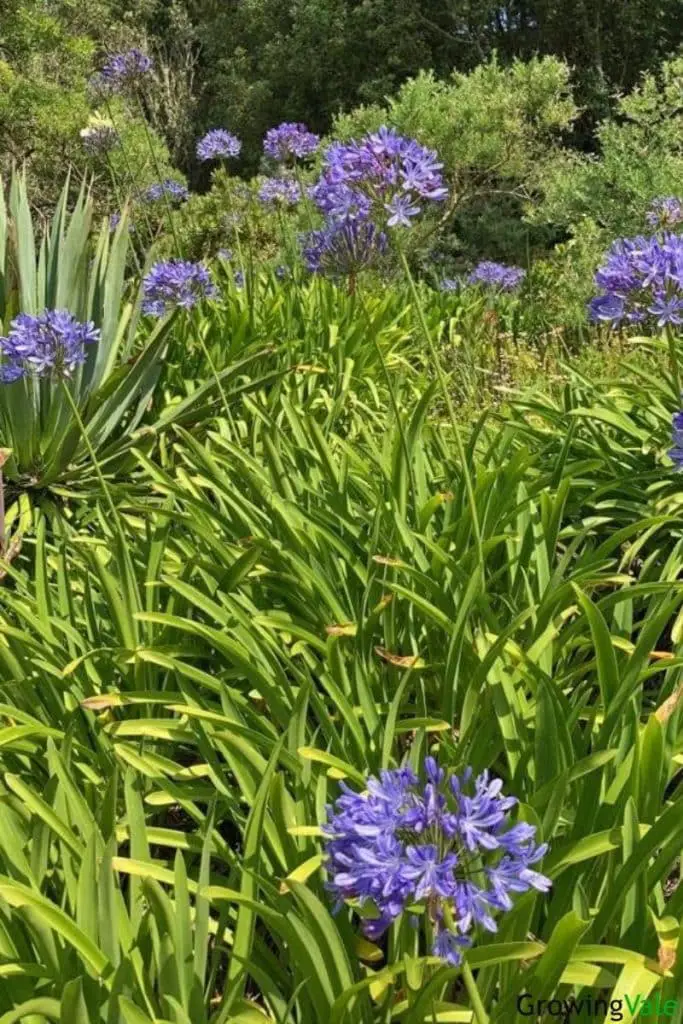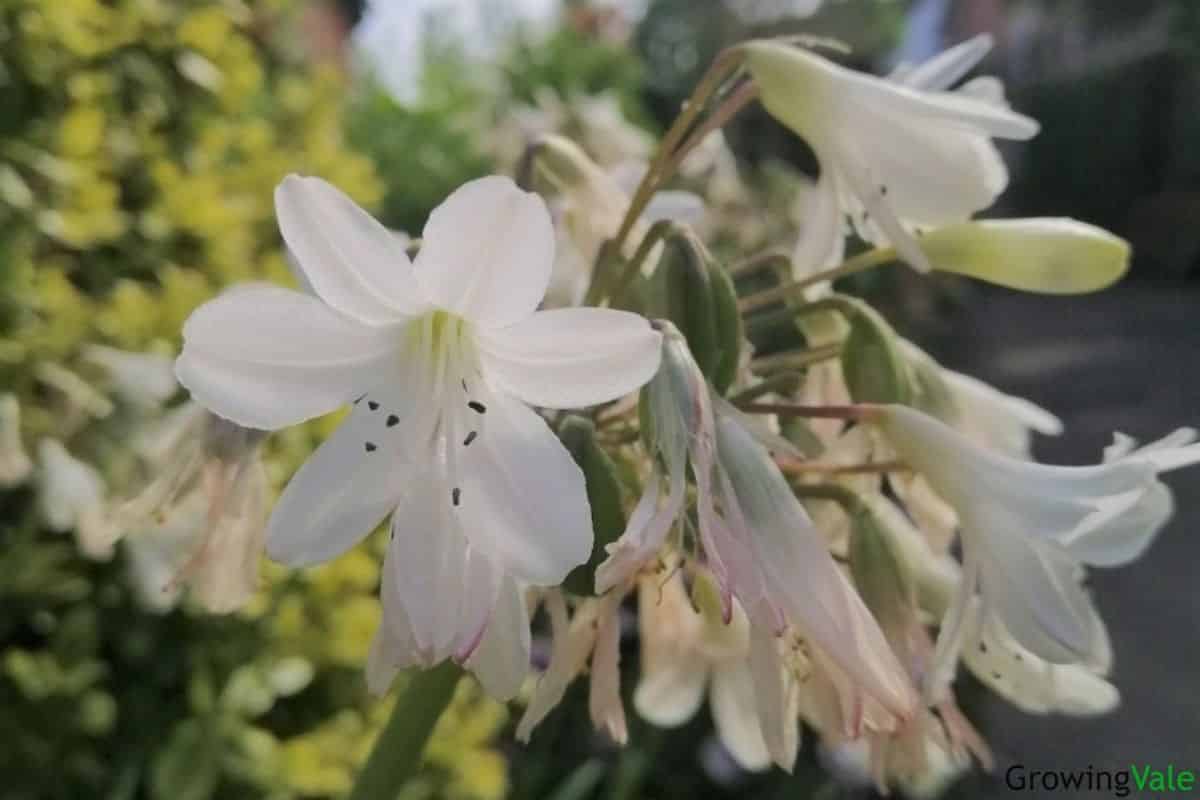The African Lily, or Lily-of-the-Nile, is a tender perennial that belongs to the genus Agapanthus and the Amaryllidaceae family (subfamily Agapanthoideae). There are 6 species in the genus plus many hybrid cultivars! They are either evergreen plants that will continue to have foliage throughout the winter or deciduous plants that will have a winter dieback.
These plants are particular favorites for container-planting or patios, but also look fantastic in the borders of cottage-style or coastal gardens! They are well-loved by gardeners for their showy flowers and long blooming period.
History
Although nicknamed Lily-of-the-Nile, the African lily is native to South Africa and was first introduced into Europe by explorers in 1679. They were previously classified within the lily (Liliaceae), onion (Alliaceae), and amaryllis (Amaryllidaceae) families, before being placed in Agapanthoideae, a subfamily of Amaryllidaceae.
The genus name Agapanthus is derived from the Greek words “agape” meaning love, and “anthos” meaning flower, which combine to become the “flower of love”.
African lily flowers grow in clusters of 20-100 and are funnel-shaped. They are born on long stalks and are typically blue-colored, however, many varieties and cultivars have been bred with white or purple flowers! Their height can range vastly between types, from dwarf cultivars that are a mere 8 inches, to tall varieties that will reach over 5 feet high!
Plant Facts
| Scientific name | Agapanthus spp. |
| Common names | African Lily, Lily-of-the-Nile |
| Genus | Agapanthus |
| Family | Amaryllidaceae, subfamily Agapanthoideae |
| Height | 0 ft. 8 in. – 5 ft. 0 in. |
| Width | 1 ft. 0 in. – 2 ft. 6 in. |
| USDA Plant Hardiness Zone | 6 – 10 (depending on variety) |
| Origin | South Africa |
| Flower colors | Blue, Purple, White |
| Blooming season | Midsummer to early fall |
| Plant/Flower special features | Long-lasting, showy flowers |
How to Plant and Grow the African Lily
When choosing lily of the Nile plants, it is important to bear in mind their color and final height. Smaller varieties should be placed at the front of the border whereas larger types are better at the back. These plants can easily be purchased as potted plants, bulbs, or rhizomes, online or from nurseries.
It is also vital to know whether they are evergreen or deciduous. Evergreen types are more tender, so in colder climates and poorly drained soils, it is easier to grow them in containers where they can easily be overwintered.

Growing African Lily Bulbs in Beds
Border plants should be planted in spring, however, evergreens will need additional protection from frost. First, prepare the bed by thoroughly de-weeding the area and working the soil, then dig a hole large enough to house the root ball/bulb of the plant. If planting a container-grown bulb, gently tease it out of the pot taking care not to damage any roots.
Place container-grown plants at the same depth they were previously in their old pot. Bulbs or rhizomes, on the other hand, need to be planted with their noses 2 inches below the soil line. Fill the soil around the hole and firmly press the soil down to remove any air pockets. Water well to settle in and make sure to space the plants at least 12-18 inches apart.
Growing African Lily Bulbs in Containers
Grow individual African lily plants in a 12-inch container filled with loam-based compost. As with beds, plants previously grown in containers need to be planted at the same depth as they were before, and bulbs/rhizomes should be planted with the nose 2 inches below the top of the soil line. It is recommended to leave 1 inch between the top of the soil line and the container edge to allow room for any water to soak in.
For displays with multiple plants, a larger container will be required with a spacing of at least 8 inches between plants. Plants grown in containers will require more frequent watering and feeding than those growing in beds and borders.
How to Propagate the African Lily
African lily plants can be propagated either by division or from seed. Those grown from seed often aren’t true to the parent plant because they hybridize rather easily, however, this means that each offspring plant will be unique and a beautiful variety may be produced!
African lilies typically need dividing every 4-6 years. To propagate them by division, lift the clumps in spring (late March – April) for the best results. Otherwise, wait until the flowering has finished before digging up the clumps. Use a sharp, clean, knife to divide the clumps into sections each with roots and at least one growing point. Plant the new divisions as directed above and expect them to flower by the following year.
To grow African lily flowers from seeds, first either purchase or harvest seed pods from the garden and allow them to dry out for 4-6 weeks in a cool, dry spot like a garden shed. After this, collect the seeds and store them in an envelope in a cool, dry place over winter.
Sow the seeds in spring in modules filled with seed compost, then sprinkle them with an additional light layer of soil. Lightly water and cover them with glass or a plastic lid and keep the temperature at 59°F. Keep the soil moist and transfer them to larger pots once their first true set of leaves appear. Overwinter the seedlings in a cool greenhouse with the additional protection of a layer of horticultural fleece during particularly cold nights.
Plant them the following spring and expect them to flower within 3-5 years.
Care and Maintenance
Here are some handy tips for getting the most out of your African lily flowers:
Soil
Plant them in well-drained soils. This is important as these plants will not tolerate water-logged soils.
Water
They will require regular watering throughout the growing season, especially during the first year of establishment. Once plants are firmly established, they will require little watering but will benefit from extra moisture in late summer, particularly during dry and hot periods. This will ensure they flower well the following year.
Container-grown plants will require regular watering to keep the soil moist, but take care that the soil doesn’t become overly wet. In winter watering should be reduced.
Fertilizer
Plants grown in borders will require feeding with a balanced fertilizer in spring when they are just coming into growth following the manufacturer’s recommendations.
Container-grown African lily plants should be fed once every two weeks from April until their flowers begin to show color. Use an all-purpose liquid fertilizer following the package instructions.
Sunlight
African lilies need to be planted in areas that will receive full sun. Avoid planting them in shady areas as this can result in poor flowering.
Temperature and Humidity
The majority of African lilies are hardy to USDA zones 8-11, however, some hardy deciduous cultivars can be grown in beds throughout the year as low as USDA zone 6.
Pest and diseases
Generally, African lily plants are trouble-free but they are susceptible to Agapanthus gall midge, a fly that causes their flowers to become discolored and deformed and even fail to appear altogether! Monitor the plants closely for the above symptoms and for orange or creamy yellow maggots living within the buds.
If plants are infected, remove and destroy infected flower heads or completely remove and destroy heavily infested plants. Container-grown plants should be repotted with fresh soil after infected flower heads have been removed.
Pruning
Deadheading flowers by cutting them off at the base when they have faded is recommended to promote longer flowering. However, some gardeners prefer to leave the dried seed heads over winter as they are quite attractive.
For deciduous types, remove yellowing leaves and spent flower heads in the fall as the plant is beginning to die back. Evergreen types can be pruned at any time to remove messy leaves and keep the display looking neat.
Overwintering
During the winter months, transfer potted plants to a more sheltered location such as a frost-free greenhouse or cold frame. If these aren’t available, placing them at the base of a south or westward-facing wall will suffice.
In cold areas, evergreen and tender varieties growing in beds should be covered with a couple of layers of horticultural fleece from November through to early April for added protection from the cold. Deciduous types will also benefit from a deep layer of mulch (6-9 inches) placed around them from late fall to early winter. Remove the mulch in early spring before the plants start to grow again.
Toxicity
Ingesting African lily plants will cause severe pain in the mouth and their sap can cause dermatitis and irritation in some people.
Uses of the African Lily
African lilies are popular ornamental plants and are favorites for containers and patio gardens. They have long-lasting blooms that make them ideal for cut flowers!
In parts of South Africa, these plants are considered to be magical and are used in traditional medicine. They have been used to treat ailments such as coughs, colds, heart disease, paralysis, and their leaves are even used as bandages!
Common Varieties and Cultivars
Here are some common African lily varieties you can grow:
- (A. africanus) Albus – This lovely plant can grow as tall as 3 feet and has clusters of trumpet-shaped white flowers that contrast nicely with the green foliage. It is an evergreen variety ideal for container planting!
- (A. caulescens) Stalked African Lily – The Stalked African Lily can grow between 2 and 6 feet! It has umbels of dark blue-violet flowers that are paler at the base. It is a fantastic choice for adding height to borders.
- (Hybrid) Black Pantha – This striking flower emerges from dark purple, almost black buds, and lightens to become dark blue-black. Clusters can be as wide as 8 inches wide, and the plant reaches a height of 40 inches.
- (Hybrid) Snow Cloud – Snow Cloud is an evergreen variety that has densely packed clusters of white flowers. It can reach 4 feet tall and is suited to container growing.
- (Hybrid) Tinkerbell – Tinkerbell has wonderful green and cream variegated foliage and pale blue flowers! It reaches heights of 20 inches and is an evergreen variety.
Conclusion
African Lilies, often called the Lily-of-the-Nile, belong to the genus Agapanthus and the family Amaryllidaceae. Although many gardeners know them as the Lily-of-the-Nile, they come from South Africa and were introduced to Europe in 1679. There are 6 species, plus a few subspecies, and many cultivars and hybrids!
They are tender perennials and can either be evergreen or deciduous. Deciduous varieties are more suited to beds and borders because they generally require less winter protection, whereas evergreen types should be grown in containers in colder climates so they can easily be given extra winter care.
African lily flowers are trumpet-shaped and grow in clusters of 20-100 on top of long stalks that rise above the foliage. Typically their flowers are blue, however, many cultivars and varieties now exist with purple and white flowers! They are favorites with gardeners for containers and patios, but are also well suited for cottage-style or coastal garden borders!

